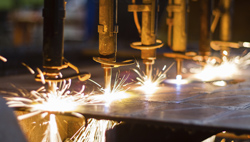New approach to model welding
More than 50 % of global domestic and engineering parts contain welded joints, meaning that welding continues to form a major pillar of many economies. Molten materials form a pool of metal that solidifies to form a joint. Understanding the chemistry at the interface and the complex crystal morphology is important to avoid cracks and failures. Scientists and engineers initiated the EU-funded project 'Modelling of interface evolution in advanced welding' (MINTWELD) to develop a multi-scale, multi-physics modelling framework to simulate interfacial chemistry and crystal formation. Unlike conventional experimental methods, this new computer modelling approach should help guide the construction of deep-sea gas and oil transportation systems. MINTWELD modelling software was able to describe the key phenomena of the welding process at all relevant length scales. Special emphasis was placed on the solid–liquid interface evolution. The framework linked atomistic ab initio and molecular dynamics (MD) interface and crack models with nano-scale phase-field (PF) grain boundary, interfacial chemistry and structure models. These were integrated with meso-scale front-tracking (FT) models, describing crystal growth and grain size distribution, and macro-scale computational fluid dynamics models of heat and mass flow. With fluid flow, solidification, PF and FT models, MINTWELD provided thermodynamic, kinetic and element segregation data relevant to the solidification interface evolution and the grain boundaries. Ab initio and MD studies provided the surface and interface energies. With real-time synchrotron imaging, scientists could observe the morphological evolution of the welding fronts and the internal flows in the weld pool. Furthermore, an electron probe microanalyser and an atom probe were used to characterise the alloy chemistry near the grain boundaries. MINTWELD researched ways of making welding simpler, safer and more economical by using new technologies and state-of-the-art computer modelling techniques. By providing control over structure and properties, MINTWELD outcomes offer the opportunity to drastically improve weld performance, thus opening new markets for the EU welding industry.
Keywords
Welding, welded joints, interface evolution, advanced welding, welding process, molecular dynamics, crack models, grain boundary, interfacial chemistry, structure models, crystal growth, interface energies, weld pool, alloy chemistry



